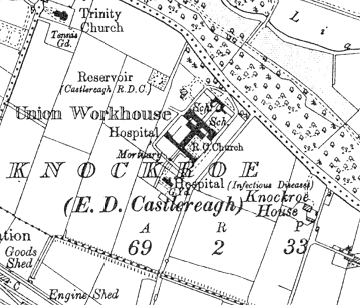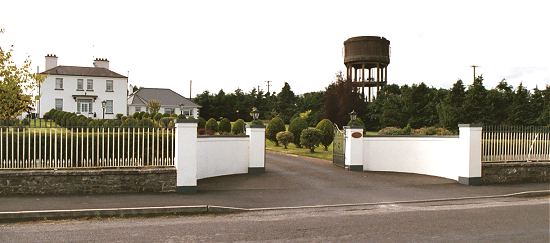Castlerea, Co. Roscommon
Castlerea Poor Law Union was formally declared on the 14th September 1839 and covered an area of 374 square miles. Its operation was overseen by an elected Board of Guardians, 27 in number, representing its 18 electoral divisions as listed below (figures in brackets indicate numbers of Guardians if more than one):
Co. Roscommon:
Artagh, Ballinlough, Ballintober, Bellanagar, Castleplunket, Castlerea (3), Frenchpark (2), Killullagh, Loughglinn (2).
Co. Mayo:
Ballaghadireen (2), Ballyhaunis (2), Bekan (2), Castlemore.
Co. Galway:
Ballymoe, Ballynakill, Glannamodda (2), Kilkerrin (2), Tampultogher.
The Board also included 9 ex-officio Guardians, making a total of 36. The Guardians met each week on Saturday at 11am.
The population falling within the Union at the 1831 census had been 85,895 with divisions ranging in size from Ballymoe (population 2,855) to Castlerea itself (9,113).
The new Castlerea Union workhouse was erected in 1840-2 on a six-acre site half a mile to the south-east of Castlerea. Designed by the Poor Law Commissioners' architect George Wilkinson, the building was based on one of his standard plans to accommodate 1,000 inmates. Its construction cost £8,485 plus £1,815 for fittings etc. The workhouse was declared fit for the reception of paupers on 6th October 1842. However, because of difficulties in collecting the poor rate needed to operate the workhouse, it did not receive its first admissions until 30th May 1846, and only then after the Poor Law Commissioners had issued the Guardians with a writ of mandamus.
The workhouse site location and layout are shown on the 1912 OS map below.

Castlerea workhouse site, 1912.
The buildings followed Wilkinson's typical layout. An entrance and administrative block at the north-east contained a porter's room and waiting room at the centre with the Guardians' board room on the first floor above.
The main accommodation block had the Master's quarters at the centre, with male and female wings to each side. At the rear, a range of single-storey utility rooms such as bakehouse and washhouse connected through to the infirmary and idiots' wards via a central spine containing the chapel and dining-hall. A mortuary lay at the rear.
During the famine in the mid-1840s, probationary wards were adapted to accommodate 24 fever patients. A fever hospital was subsequently erected at the south of the site.
Conditions at Castlerea during the famine were graphically described in a letter in a Quaker pamphlet in 1847:
At the Castlerea workhouse a shocking state of things existed, the poor inmates lying upon straw and their dormitories being in such a state of dirt that we were unable to venture into them. In this workhouse there are at present 1,080 paupers, but the last 434 were admitted in so hurried a manner that there is neither bedding nor clothes for them; it is probable that there will be frightful mortality among the inmates. In the children's room was collected a miserable crowd of wretched objects, the charm of infancy having entirely disappeared and in its place were to be seen wan and haggard faces, prematurely old from the effects of hunger and cold, rags and dirt. In the schoolroom they spend some hours every day in hopeless listless idleness; though there are both a schoolmaster and schoolmistress there are no books nor slates, nor any of the apparatus of a school.
In 1850, the southern part of the Castlerea Union went to become part of the new Glenamaddy Union.
The workhouse remained in operation until 1920 when, under a scheme to reduce the number of workhouses in the area, the Strokestown and Roscommon unions were re-amalgamated, and the Castlerea and Strokestown workhouses closed, to the consternation of local traders who were heavily dependent on Union Contracts. Shortly afterwards the buildings were demolished and the site is now used for residential purposes.

Castlerea former workhouse site from the north-east, 2003.
© Peter Higginbotham.
Records
Note: many repositories impose a closure period of up to 100 years for records identifying individuals. Before travelling a long distance, always check that the records you want to consult will be available.
- Roscommon County Library, Abbey Street, Roscommon.
Bibliography
Links
- None.
Unless otherwise indicated, this page () is copyright Peter Higginbotham. Contents may not be reproduced without permission.


